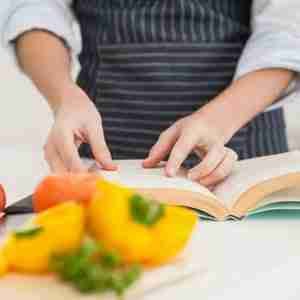Last Updated on July 20, 2022 by Dr Sharon Baisil MD
Do you love to cook and want to share your recipes with the world? Self-publishing a cookbook is an excellent way for authors or chefs to share their work with readers. This article will guide you through the process of cookbook publishing, from writing the book outline to self-marketing and distributing your book.
1. Determine whether you want to write a physical cookbook or an eBook
Physical Cookbooks
Physical books are printed on paper and bound together. These types of cookbooks make great gifts, especially for family members who might not have access to the internet regularly. Some disadvantages include shipping costs, slower turnaround time if you need revisions and more expensive upfront costs.
eBooks
With an eBook, you can sell your book online, and there are no printing or shipping expenses. However, the author is responsible for creating their graphics to go with their content, which can be time-consuming if they do not know how to use Adobe Photoshop or Illustrator.
You may want to consider combining the two formats. You can first release an ebook and later sell a physical copy of your book on Amazon or another publishing service.
2. Budget for your book
The next step you should take is to figure out what budget you have to self-publish the book.
There are a few different ways that authors can finance their books:
Out of pocket – You pay the costs yourself, including editing and design services as well as printing expenses if necessary. This is typically done by self-publishing companies, which will take a cut from your book sales in exchange for their services.
Finance through an outside source – Some authors seek out investors or loans to pay for all of the expenses themselves and keep 100% of the profits once the books have been sold. This is considered “self-publishing” because you are responsible for the entire process.
Partner with a self-publishing company – This is similar to financing through an outside source but is typically done by paying a monthly fee to one of many companies that offer this service. You can then create your book, and they will handle all of the costs associated with publishing, design, and promotion. If you choose this option, be sure to do your research so that you can find a reputable company with a good track record of satisfied customers.
In the beginning stages of writing your book, it’s helpful to know what budget will work for you. Then as you’re getting closer to publishing day, you can look at self-publishing services and decide which one is best for your book.
3. Photograph your recipes
If you’re writing a cookbook, it’s very important to provide high-quality photographs that correspond with your content. You can hire a photographer who is an expert in food photography or take the photos yourself (make sure they are top-notch and professional looking). If you decide to do this yourself, we recommend using natural light outside if possible because indoor lighting will not always give you the results you are looking for.
If your images aren’t coming out quite right, there are a few different options to consider:
Hire a photographer: This is typically an expensive route, but it will be worth it if your book becomes popular and sells many copies in the future.
Use clip art or free online images: You can find plenty of free, high-quality food photos on websites like Pixabay and Unsplash. However, be sure to check the license for each photo before downloading it, as some are limited in their use or require attribution from the author.
If you’re not a good photographer yourself but still want great-looking images in your book, the best option is to hire a photographer.
4. Conceptualize your book
The next step in getting self-published is to figure out the “big idea” behind your cookbook project. What are you trying to accomplish with this project? Who will be reading it and why?
Here are some questions that can help guide you towards developing a compelling concept:
What’s unique about my recipes or my approach to food?
What can I add or bring to the table that no one else has done yet? What makes me special, different from everyone else, and worth reading about?
Who is my target audience? And why would they want this book in particular versus a competitor’s cookbook on the same topic?
Is there a specific goal you want to accomplish with your cookbook? Do you want it to be a gift for family and friends, or do you eventually hope that it becomes commercially successful, landing on the New York Times bestseller list and making lots of money?
Answering these types of questions will help develop a concept. Once you have an idea about what kind of cookbook you’d like to make, it’s time to start developing your recipes.
For example, if you wanted to create an entire cookbook for beginner cooks that features simple and accessible ingredient lists, this might be the right book design for you.
5. Create your recipes
It’s now time to start developing recipes after you’ve finished your idea. You may do it however you want, but we propose using the following components:
Introduction – The author explains why they are qualified to write this cookbook project and their cooking experience. It should also include information about their target audience and why they should be reading this book.
Ingredients – The ingredients list will vary depending on what kind of cookbook you’re writing, but generally speaking, it’s a good idea to include the following:
- Name of recipe (and maybe an abbreviated version)
- Type of dish (entrée or appetizer, etc.)
- Ingredients (in order of use)
- Equipment needed to make the dish
Method – This is where the author gets into step-by-step cooking instructions. It’s also helpful if they include any tips or tricks that are specific to this particular recipe, i.e., “don’t forget to salt your pasta water before adding the pasta!”
The final section is where you can include any additional information that didn’t fit elsewhere in your cookbook. This could be a simple photograph of the dish, interesting facts about an ingredient, or step-by-step photos to help readers through tricky parts of cooking.
6. Testing and revising recipes
Hire home cooks as recipe testers
Recipe testing is an invaluable step in the self-publish process. A professional will tell you if your recipe works and how it can most effectively be made for others to follow along with at home.
Ask friends and family for feedback
It’s also a good idea to ask your friends and family to test out the recipes in your book because they’ll likely be honest with you about what works and doesn’t work.
Revise, revise, revise!
After getting some initial edits from others, go back through each recipe yourself over multiple times until you’re sure that it’s perfect. Don’t be afraid to try out different approaches, ingredients, and methods until you figure out the best way for each dish to come together!
7. Editing, design, and layout
Find an editor to go through your book with a fine-toothed comb.
Your recipes should be easy for others to follow at home, so the editing process must be well done. This person will help you make sure each sentence makes sense, and all of the measurements are accurate. They will also be the ones to suggest any changes in wording or structure that might make your recipes sound more appealing.
It’s up to you if you want a publisher to design and layout your book for free, but many do offer this service either as part of their publishing contracts or when an author signs with them directly.
You’ll need to decide whether you want to invest the extra time and energy into learning how to do it yourself or if you’d rather spend that effort on developing more recipes.
You can also hire a freelancing professional book designer on websites like Upwork and Fiverr.
8. Self-publishing a Cookbook
Amazon KDP
Amazon KDP is a great option for your self-published cookbook because it’s free to set up an account, you get 70% of royalties on each sale, and your distribution options are incredibly easy to use.
CreateSpace
CreateSpace is a great option if you want to publish through Amazon but prefer the convenience (and often cheaper) of traditional publishing services. They offer similar services to KDP but charge their set-up fee and take a larger percentage of sales (40%).
Traditional publisher
If you do not want the self-published cookbook route, traditional publishing companies will help with the entire process from start to finish.
9. Promoting and marketing
Build an email list and collect subscribers
If you want to sell many books, it’s important to gather as many people as possible on your email list. This is how you’ll communicate with them about new recipes or book signings, so make sure that the sign-up form is easily accessible from all pages in your cookbook.
Create a blog or a website
A website is another opportunity to connect with fans and sell books. Offer freebies! It provides a place for people to leave reviews of your cookbook online, so they’re important for building brand recognition and trustworthiness as an author.
Offer some bonus through email sign-ups like exclusive recipe previews or by giving away a PDF of your book. This is also where you can start to build buzz about the release date, so make sure it’s well-promoted!
Start sharing recipes through social media
Before getting your cookbook published, you should begin promoting some of the recipes online through social media platforms like Pinterest, Facebook, Twitter, and Instagram.
Approach a food blogger for a cookbook review
If you don’t have the money to hire someone who can help promote your book, reaching out to food bloggers or other notable figures in the cooking world is another way of getting some exposure. Just make sure that you’re offering them something they want (for example, an exclusive preview of recipes before anyone else)
Conclusion
I hope these nine tips have been helpful to you. If you are considering self-publishing a cookbook, keep in mind that it is not an easy feat and will require some time commitment on your part. However, the payoff can be great if done right! Do you need help with any of the steps? Let us know by commenting below.
Frequently Asked Questions about Self Published Cookbook
How much does it cost to self-publish a cookbook?

Answer: Here are the costs to self-publish at the top 3 platforms:
KDP Print on Demand – Free
IngramSpark – $49
Lightning Source Inc. – $99 for printing and setup, then per book prices dependent on paper quality and cover type/thickness, usually in the range of around 40 cents to a dollar each ($0.60-$1)
Where can I self-publish a cookbook?
Answer: You have a couple of great options for self-publishing, including Amazon KDP, Lulu, and Ingram Spark. There are also countless platforms available to you if these don’t work. Apple iBooks Author is one option that will allow you to create cookbook content in various styles and layouts that can be shared with the world on the Apple store. Nook Press is another good resource for authors who are interested in publishing their content using the Barnes&Noble publishing process.
How much does it cost to self-publish a cookbook on Amazon?
Answer: It’s completely free to publish your book on Amazon.
The two parts are the cover design and interior formatting, which Amazon’s Layout Service has done for you. This means that you upload your manuscript in any format that Microsoft Word supports, plus all the images in whatever format they come to Amazon (e.g., large JPEGs), and they will convert them into Kindle-ready ePub files for use in selling your book on the Kindle store too- for no additional charge.
How many recipes do you need for a cookbook?

Answer: A standard cookbook is 40-50 recipes, with each recipe comprising 4-6 pages of content.
If you decide on a hardcover format (if your budget allows for this), the thickness will depend on how many photos you choose to include; generally, about 100 recipes can fit into a hardcover book.
The cookbook by blogger and author Jenny McGruther, The Nourished Kitchen: Farm-to-Table Recipes for the Traditional Foods Lifestyle (check it out here), is a great example of this standard.
Is writing a cookbook profitable?

Answer: Yes, writing your cookbook is profitable, as people with the time and inclination to cook at home will always want new recipes.
More importantly, cookbook authors across all genres tend to earn an average of $2.25 for each book sold. An author can also sign up for royalties on books sold through publishing partnerships that may go as high as 25%. A recipe could be worth between $100 and $1000 in licensing fees alone if widely adopted and re-published under a brand.
Recipe creators can also make money from endorsement or consulting fees after becoming established as authorities in their area of expertise. However, they face stiff competition from more experienced members of the food world like authors, bloggers, and chefs.
Can you make money selling a self-published cookbook?
Answer: Like many things, the odds of success will depend on a combination of effort and luck. In most cases, you need to have or create some platform that can be used as leverage to sell your book.
For example, connecting with food bloggers who may want to review it is a great way to get exposure and have your book in front of a targeted audience.
What blogging platform do you use for a cookbook blog?
Answer: WordPress is the most popular blogging platform, with over 30% of online users choosing it as their go-to blog software.
It’s easy to use, flexible, and has a huge selection of free themes that you can customize easily. However, since WordPress allows for more customization than other platforms like Tumblr or Blogger (owned by Google), there’s a higher risk that an incompatible or poorly-coded theme can break your site.
How do you buy a domain for a cookbook blog?
Answer: The easiest way to acquire .com is through GoDaddy, which offers free privacy protection and SSL certificates with all registered domains. It’s important to note though there are plenty of other domain providers who also offer great services.
Which is the best hosting service for a cookbook blog?
Answer: Bluehost is one of the best hosting services for WordPress blogs and offers unlimited bandwidth, storage space, and email accounts. It also comes with easy-to-use site-building tools that will help you get your blog up and running in no time. You can even purchase SSL certificates to make sure all traffic on your website is encrypted and secure.
What cookbook blogs can you recommend?
Answer: Love and Olive Oil, Homesick Texan, Pioneer Woman (and its sister site SweetPhi), and Smitten Kitchen all have strong followings regarding food blogging.
These sites feature great recipes that cover a wide range of cuisines and styles. They are also great examples of building a strong following online, which will help you sell your book.
Why is a blog important for a cookbook author?

Answer: It’s no secret that blogs are an integral part of the food world. Most publishers now require an author to have some online presence as proof they can engage with people and cultivate readership before signing them on as authors.
As a cookbook author, you’ll need to create a comprehensive blog and provide an overview of your entire book. The content should be well-organized, engaging, and informative so potential readers will get excited about your upcoming cookbook.

Hi, I am a doctor by profession, but I love writing and publishing ebooks. I have self-published 3 ebooks which have sold over 100,000 copies. I am featured in Healthline, Entrepreneur, and in the Massachusetts Institute of Technology blog.
Whether you’re a busy professional or an aspiring author with a day job, there’s no time like now to start publishing your ebook! If you are new to this world or if you are seeking help because your book isn’t selling as well as it should be – don’t worry! You can find here resources, tips, and tricks on what works best and what doesn’t work at all.
In this blog, I will help you to pick up the right tools and resources to make your ebook a best seller.

